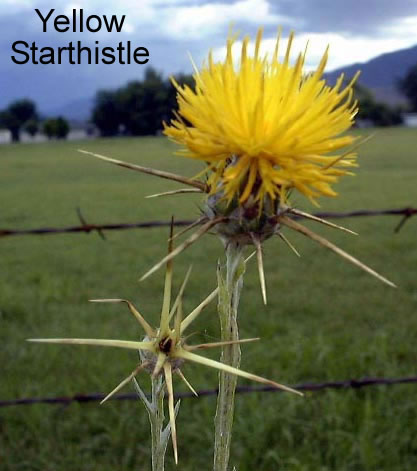 Yellow and Malta Starthistle - April 27, 2005 Jeff Schalau, County Director, Agent, Agriculture & Natural Resources Arizona Cooperative Extension, Yavapai County  Malta starthistle (Centaurea melitensis) is an invasive weed that occupies grasslands, open woodlands, fields, pastures, roadsides, and disturbed areas in most western states. It is found in several locations within the Verde Valley including areas of Sedona, Lake Montezuma, and Cottonwood. Malta starthistle’s close relative, yellow starthistle (Centaurea solstitialis), has become established on the south end of Camp Verde. Both of these annual weeds get their start in the cool season and now is a good time to control them – before they flower and produce seeds. Malta starthistle (Centaurea melitensis) is an invasive weed that occupies grasslands, open woodlands, fields, pastures, roadsides, and disturbed areas in most western states. It is found in several locations within the Verde Valley including areas of Sedona, Lake Montezuma, and Cottonwood. Malta starthistle’s close relative, yellow starthistle (Centaurea solstitialis), has become established on the south end of Camp Verde. Both of these annual weeds get their start in the cool season and now is a good time to control them – before they flower and produce seeds.Both plants start out as rosettes that resemble a dandelion with fuzzy leaves. During the rosette stage, they also develop a stout taproot. In late spring/early summer, they begin to grow erect stems that are leafy and have longitudinal wings of green leaf-like tissue. It is difficult to discern between the two species until they flower. Both have bright yellow flowers with prominent spines radiating from the flower base (called the involucre). The spines on yellow starthistle flowers are ¾ to 1 inch long, very stiff, and pointed like a cactus spine. Malta starthistle spines are shorter, not as stiff, with three or four pairs of smaller spines at the base. Horse owners should be on the lookout for yellow starthistle as it can be toxic. Ingestion of significant quantities can cause “chewing disease” which is characterized by fatigue, lowered head, an uncontrolled rapid twitching of the lower lip, tongue-flicking, involuntary chewing movements, and an unnatural open position of the mouth. Poisoning occurs after a horse has ingested 50 to 150% of its body weight over a one to three month period. Toxicity effects are cumulative and irreversible. Malta starthistle has also been implicated in case reports of chewing disease. In most cases, poisoning occurred where horses had little or no other palatable feed available to them.  When starthistles (and other invasive species) take over wildlands, they impact wildlife populations and livestock grazing by reducing available forage. Watersheds are also impacted because soil stabilizing plant populations like grasses are displaced. Property values are also decreased because of the above mentioned negative impacts and control costs. Invasive species must be dealt with quickly otherwise we spend greater amounts of money to manage the growing population. When starthistles (and other invasive species) take over wildlands, they impact wildlife populations and livestock grazing by reducing available forage. Watersheds are also impacted because soil stabilizing plant populations like grasses are displaced. Property values are also decreased because of the above mentioned negative impacts and control costs. Invasive species must be dealt with quickly otherwise we spend greater amounts of money to manage the growing population.Small infestations of starthistles can be controlled by hand pulling. Properly timed grazing of goats, sheep, and cattle can also be effective. Mowing can also be effective if properly timed. For yellow starthistle, the recommended treatment is to mow below the lowest branches when 2 to 5% of the total population of seed heads is in bloom. Sometimes mowing results in a second flush of growth that produces flowers nearer to the ground. Think of how dandelions respond to mowing by producing shorter flower stalks. Repeated shallow cultivation to till under young seedlings is effective in crop fields. Herbicides containing clopyralid are also effective in controlling starthistles. Combinations of management approaches are best but will only be effective in controlling starthistles if applied over the course of several years. Control treatments should also be combined with revegetation to provide some competition. In areas where starthistles have become well established, control programs may need to continue indefinitely. Insects have also been used to provide some biological control. While this approach helps, it will never impact the population significantly unless combined with other control strategies. As you can see, yellow and Malta starthistle are tough customers and take a significant toll on people, animals, and the ecosystems. If we act now to control yellow and Malta starthistle, we may have a chance to reduce populations or at least stop their spread. The Verde Valley Weed Management Area (VVWMA) is actively working to control starthistles and other invasive species. The VVWMA is a grassroots volunteer group that provides information and technical assistance about noxious/invasive species management. The University of Arizona Cooperative Extension has publications and information on gardening and pest management. If you have other gardening questions, call the Master Gardener line in the Cottonwood office at 646-9113 ext. 14 or E-mail us at mgardener@verdeonline.com and be sure to include your address and phone number. Find past Backyard Gardener columns or submit column ideas at the Backyard Gardener web site: http://cals.arizona.edu/yavapai/anr/hort/byg/. |